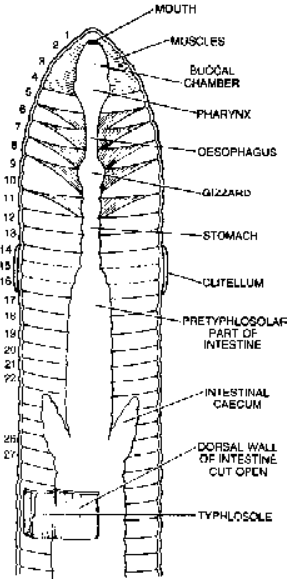
Digestive System of Earthworm
Anatomy of Earthworm,Cockroach & Frog of Class 11
Digestive System
Alimentary Canal : A straight tube running throughout the length of the body. It can be divided into following parts :
- Mouth : A crescentic aperture ventral to the prostomium and situated in the first segment or peristomium or buccal segment.
- Buccal chamber : Mouth leads into buccal cavity or chamber. It is a short, thin-walled chamber which extends from first segment to the middle of the 3rd segment. Its epithelial lining is thrown into longitudinal folds.
- Pharynx : Buccal chamber leads into a spacious pear shaped muscular pharynx which extends upto the fourth segment. Pharyngeal cavity is narrow and dorso-ventrally compressed, due to the presence of a large, thick mass known as pharyngeal mass or pharyngeal bulb. It is made up of darkly-stained, irregular glandular cells or chromophil cells and muscle fibres. The glandular cells produce a salivary secretion, which is poured into the cavity of the pharynx. The lateral pharyngeal walls are pushed inside to form a horizontal shelf on each side. The two shelves, thus, divide the pharyngeal cavity into a dorsal or salivary chamber and a ventral or conducting chamber. The salivary secretion contains mucus and digestive enzymes.
Oesophagus : Pharynx is followed by a straight, narrow, long tube called gullet or oesophagus. This thin-walled tube extends from the fourth upto the seventh segment.
Gizzard : In the 8th segment, oesophagus becomes enlarged so as to form a prominent, hard, oval, thick-walled structure, the gizzard. Internally, it is lined by a chitinous cuticle. The muscular walls of the gizzard help in breaking up the food particles by contraction.
Stomach : Gizzard leads into stomach, which extends from 9th to 14th segment. Both the ends of stomach are provided with spincters. The walls of the stomach are folded, vascular and glandular. The glandular folds have calciferous glands found only in Eutyphoeus and Lumbricus. These cells produce a calcareous fluid which neutralises the acidic effect of decomposing leaves, that are taken as food by earthworm.
Intestine : Behind the 14th segment, there is a wide, thin-walled tube, the intestine. It runs straight upto the anus. It has a beaded appearance due to constriction corresponding to septa. Its internal lining is ciliated, folded, vascular and glandular.

Fig. Alimentary canal of earthworm
In the 26 th segment, there are two conical outgrowths, one on either side, which are known as intestinal caecae. These extend forward upto 22 nd segment and end blindly, their function is unknown.
In the intestine behind the intestinal caecae, there is median dorsal ridge-like fold known as typhlosole which projects into the intestinal cavity.
It is found in the intestine upto 25 th segment in front of the anus. Thus intestine can be divided into 3 regions:
Pre-typhlosolar region : Extends from 15th to 26th segment. Its wall is internally folded toform minute processes, the villi, and is highly vascular.
Typhlosolar region : This part extends from anterior 27th segment to the 25th segment in front of the anus. Both pre-typhlosolar and typhlosolar parts are digestive and absorptive in function.
Post-typhlosolar region : Also known as rectum and situated in the last 23-24 segments. It communicates to the outside through a terminal anus.
The gut wall consists of four layers in succession : -
Peritoneum : Outermost layer consisting of tall and narrow cells. Sometimes on the stomach and intestine, the cells of the peritoneum are filled with minute yellow refractive granules known as yellow or chloragogen cells. The function of these cells is not definite but are said to serve for storage of reserve food, deamination of proteins etc.
Muscles : They include an outer layer of longitudinal and inner layer of circular muscle fibres. The muscles are unstripped or involuntary.
Enteric epithelium : Consists of a single layer of columnar cells which become ciliated on the roof of pharynx, glandular in stomach and absorptive in intestine.
Cuticle : It is present in the buccal cavity as a thin lining, while in the gizzard as a thick layer.
Food : Consists of organic matter or humus. To obtain food material, earthworms swallow a large quantity of soil.
Earthworm protrudes and retracts its buccal cavity during its movement. The food is thus taken into the mouth by the sucking action the pharynx. The passage of food into the alimentary canal is effected by peristaltic movements. The juice found in the pharynx contains mucin and proteolytic enzyme. Mucin lubricates the food. The process of digestion is intercellular as it
occurs in the cavity of the gut.
The undigested food material is passed out with the large quantities of soil particles in the form of worm castings.





